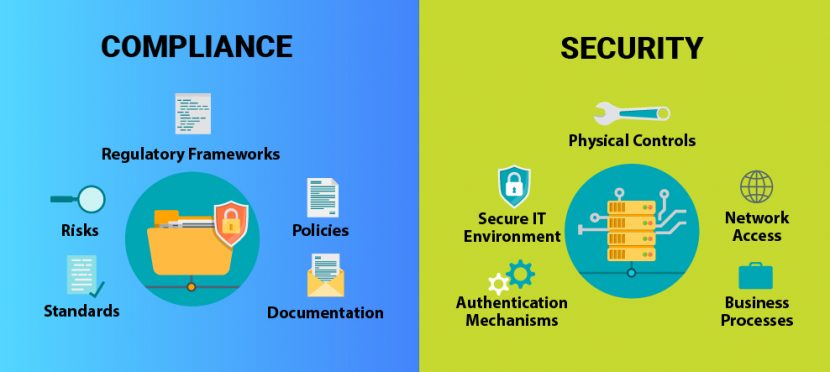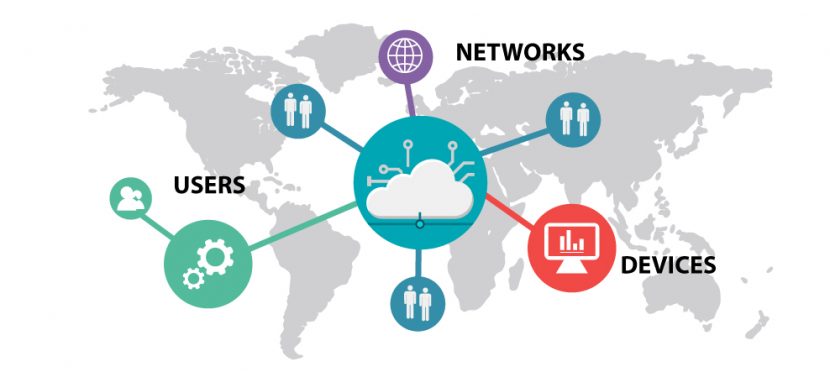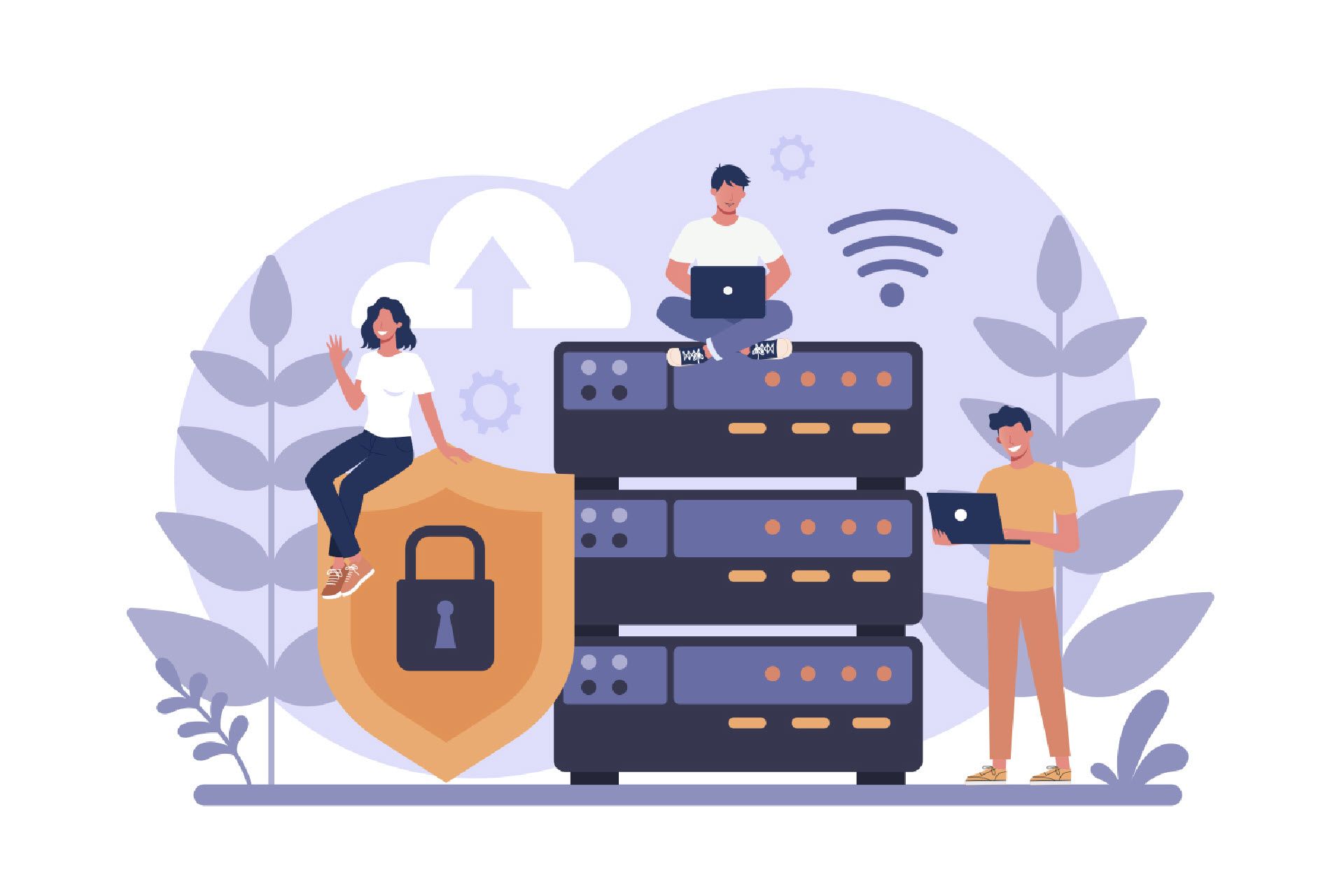The time has arrived to think differently about security and compliance. Compliance is not security. In fact, an organization can be compliant but still not secure.
Compliance doesn’t always achieve security.

Preparing For Today's Security Challenges
Information technology has grown in leaps and bounds over the last two decades. with the industry set to surpass $5 trillion in 2019. With this immense growth come complex new compliance and security challenges. Industry insiders understand that it’s increasingly important to control how companies share, store, and receive information.
IT compliance frameworks are now in place to ensure data is regulated securely, but they can differ extensively.
At its core, becoming secure and compliant means securing information assets, preventing damage, protecting them, and detecting theft. These are the main principles of cybersecurity teams, as they implement frameworks, which are predominantly technical to achieve compliance.
A company can protect its data effectively, if it follows compliance frameworks and maintains strong security practices. To achieveproper protection, companies must understand that compliance is not the same thing as security. However, security is a major part of compliance.
What are the Differences Between Compliance and Security?
Compliance focuses on the kind of data handled and stored by a company and what regulatory requirements apply to its protection. A company may have to align with multiple frameworks, and understanding these frameworks can be difficult. The main goal is to manage risk beyond information assets. They encompass policies, regulations, and laws covering physical, financial, legal, or other types of risk.
Compliance means ensuring an organization is complying to the minimum of the security-related requirements.
Security is a clear set of technical systems and tools and processes which are put in place to protect and defend the information and technology assets of an enterprise. While compliance is an important business requirement, it is not the primary focus of a security team.
Security can include physical controls, network access restrictions, and standardized methods provided by third-party vendors. Security is more straightforward than compliance, which is multifaceted and depends on the company's data type and security posture.
Compliance and Security Based on Specific Frameworks
Compliance examines a company’s security processes at a given moment in time and compares them to regulatory requirements, which stem from legislation, industry regulations, or best practices.
Compliance frameworks include:
HIPAA
HIPAA (Health Insurance Portability and Accountability Act) applies to companies in the healthcare industry. It legislates how companies should handle and secure patients’ personal medical information. HIPAA compliance requires companies who manage this kind of information, to do so securley.
Initially, HIPAA aimed to standardize how the health insurance industry processed and shared data. It has now added provisions to manage electronic breaches of this information as well.
SOX
The Sarbanes-Oxley Act (also called SOX) applies to the corporate care and maintenance of financial data of public companies. It defines what data must be kept and for how long it needs to be held. It also outlines controls for the destruction, falsification, and alteration of data.
SOX attempts to improve corporate responsibility and add culpability. The act states that upper management has to certify the accuracy of their data.
All public companies must comply with SOX and its requirements for financial reporting. Classifying data correctly, storing it safely, and finding it quickly are critical elements of its framework.
PCI DSS
PCI DSS compliance is the Payment Card Industry Data Security Standard created by a group of companies who wanted to standardize how they guarded consumers’ financial information.
Requirements that are part of the standard are:
- A secured network.
- Protected user data.
- Strong access controls and management.
- Network tests.
- Regular reviews of Information Security Policies.
Compliance levels vary depending on the number of transactions a company processes anually.
SOC Reports
Service Organization Control (SOC) reports govern how companies manage financial or personal information. There are three different SOC reports:
- SOC 1. Financial information controls.
- SOC 2. Personal information and system security.
- SOC 3. Public-facing reports without confidential details.
The American Institute for Chartered Public Accountants (AICPA) defined them as part of SSAE 18.
ISO 27000 Family
The ISO 27000 family of standards outlines minimum requirements for securing information. As part of the International Organization for Standardization’s body of standards, it determines the way the industry develops Information Security Management Systems (ISMS).
Compliance comes in the form of a certificate. More than a dozen different standards make up the ISO 27000 family.
Security Covers Three Main Aspects of Your Business

1. Networks
Networks allow us to share information quickly over vast distances, but they also introduce risks. A breached network can do untold amounts of damage to a company.
A data breach of personal information can cause damage to the company’s image. Data loss or destruction can also open companies to criminal liability, as they are no longer in compliance with regulations.
Network security tools prevent unauthorized access to the system. Firewalls and content filtering software protects data as they only allow valid users.
2. Devices
A user’s personal device that connects to a company network can inject unknown code into the system. Similarly, clicking on the wrong email attachment can quickly spread malicious software.
Antivirus and endpoint scanning tools stop attackers from gaining access to the device. Phishing attacks and viruses have known signatures making them detectable and preventable.
Segmenting access to the network by device, user, and facility limits the spread of malicious software.
3. Users
Careless users are a significant risk for any company. They don’t know they have been compromised and don’t know they are enabling an online attack. Phishing emails are now responsible for 91% of successful cyber-attacks.
Training users to be mindful can help limit innocuous yet dangerous actions. Training can increase security if employees know the risks involved in their daily use of technology.
Compliance and Security: The Perfect Alliance
Every company needs security. Most will already have some form of protection when it comes to IT infrastructure. This could even mean the bare minimum of having an antivirus installed on a workstation or using the basic Windows Firewall.
Turning security tools into a compliant IT system requires more effort. Company’s need to prove their compliance with the regulatory standards when a compliance audit happens.
Creating one system, an alliance of both security and compliance, in a systematic and controlled way is the first step in reducing risk. A security team will put in place systemic controls to protect information assets. And then a compliance team can validate that they are functioning as planned. This type of alliance will ensure that security controls won’t atrophy, and all the required documentation and reports are accessible for auditing.
Getting Started on a Secure Path
Compliance that meets a specific framework builds trust in a company. Although regulations will be the driving force behind compliance, the added benefits that come with it are helpful.
A formal assessment of security procedures and systems can highlight areas of concern that need clarification and understanding. Although management should trust administrators to make critical decisions affecting a company’s infrastructure, understanding all the relevant information about security rests with management. Using compliance frameworks to find shortcomings in security is essential when looking at those decisions.
To achieve compliance and security:
- Listing the current security tools in use.
- Conduct a risk assessment of the types of information processed.
- Study the requirements related to the framework.
- Analyze the gaps in your current controls in regards to the requirements.
- Plan the way forward to solve major deficiencies.
- Test the effectivness of the implemented solutions.
After applying these steps to a system, conducting regular assessments is the key to success. Compliance and security need to work hand in hand; it does not have to be security versus compliance.
They work in unison; how? Using a compliance framework, assessing security systems, correcting deficiencies, and then beginning assessments which are set on a regular schedule.
Security and Compliance: A Symbiotic Relationship
Security and compliance are essential components of modern bussinesses. Understanding how they relate to data security is critical.
The IT Industry relies heavily on the public’s trust, and companies that provide them with Information services need to have stellar reputations. A failure in security can break a business.
Security and compliance complement one another. Compliance alone does not guarantee security, but when both are implemented in harmony, they ensure the protection of data and the integrity of an organization.
Now that you understand the differences between security versus compliance read about the best security testing tools recommended by professionals. It’s time to take action against potential data threats and guard your cybersecurity.



